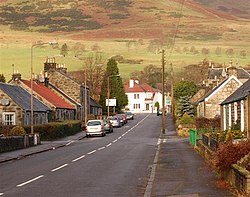Dollar
| Dollar | |
| Clackmannanshire | |
|---|---|
 Dollar | |
| Location | |
| Grid reference: | NS964978 |
| Location: | 56°9’45"N, 3°40’5"W |
| Data | |
| Population: | 2,877 (2001) |
| Post town: | Dollar |
| Postcode: | FK14 |
| Dialling code: | 01259 |
| Local Government | |
| Council: | Clackmannanshire |
| Parliamentary constituency: |
Ochil and South Perthshire |
Dollar is a small town in Clackmannanshire. It is one of the Hillfoots Villages, situated between the Ochil Hills range to the north and the River Devon to the south.
At the foot of Dollar Glen is The Mill Green. Here there is also a small museum which is run by volunteers, which contains an interesting collection of local items, and much information about the former Devon Valley Railway, which closed in the 1970s.

The town is now largely a commuter village for Stirling and even for Edinburgh and Glasgow.
Because of the success of its independent school, Dollar Academy, and its tranquil environment, the town draws young and reasonably well-off families, giving it a slightly different character from the other Hillfoots Villages.
Castle Campbell
The major attraction in Dollar is the five hundred year-old Castle Campbell, lowland seat of the Duke of Argyll, where Mary, Queen of Scots, once lived in the 16th century. The residence was chosen for its proximity to the court in Edinburgh and Clackmannan Tower, Alloa, Stirling Castle and Linlithgow Palace.
The walk to the castle is a vigorous ascent by a spectacular series of paths, bridges and walkways within the deep gorges of the glen and its tributaries. Unfortunately, the most spectacular section has had to be closed due to the risk of landslip (a part of which was re-opened Summer 2007), but alternative routes are available. There is also a road, accessible by car, to the castle for the less energetic.
Sports are catered for, the town having an 18-hole golf course (notable for its steep inclines and lack of bunkers), a cricket club, a tennis club, a squash club and a bowling club. The Ochil Hills that overlook Dollar provide opportunity for mountain biking. The nearby River Devon is occasionally used for fishing.
Churches
War memorials
The town has two separate war memorials, one for each world war. In the grounds of the Academy a fine bronze figure with outstretched hands faces westwards and commemorates the fallen of the First World War, and which also has names added for Northern Ireland. The dead were largely from the Academy, two non-Academy deaths (the Archibald brothers) are indicated by the word "parish" against their names. The Second World War memorial is more modest, in the small public garden on the main road, where the road suddenly twists, at is most visible when driving briefly southwards towards the pocket park, as part of the overall west-to-east route. Both memorials are by local sculptor, George Henry Paulin.
History
Dollar is now mainly residential; however, for a long time it was known for its industries. Attempts were made to mine lead and copper in Dollar Glen from the 18th century and possibly earlier, but these were of no economic significance. Coal mining in the area began around the same time and, until 1973, supplied the Kincardine Power Station, and later, the Longannet Power Station with coal from the Upper Hirst seam. A tiny private non-NCB coal mine operated from the Harviestoun estate from the mid 1970s, partly filling the gap that the closed NCB left, whilst there was still local demand for coal.

In common with the other Hillfoots Villages, the textiles industry played an important part in the town's development. The Harviestoun Brewery was established west of Dollar in 1985, before its move to Alva.

Outside links
- Dollar museum
- Dollar on Undiscovered Scotland
- ClacksNet - Clackmannanshire's Community Network
- Look Aboot Ye - Clackmannanshire Community News, Information and Forums
- Historical information on Dollar from the Vision of Britain website
References
| The Hillfoots Villages of Stirlingshire, Clackmannanshire and Perthshire |
|---|
|
Blairlogie • Menstrie • Alva • Tillicoultry • Dollar • Pool of Muckhart |